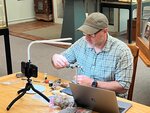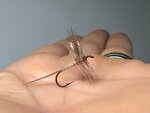Friday’s rainstorm was much welcomed, as we desperately need rain – last week was the first time we can ever remember seeing lawns burned brown in May, and the Beaverkill on Friday …
This item is available in full to subscribers.
Please log in to continue |


Friday’s rainstorm was much welcomed, as we desperately need rain – last week was the first time we can ever remember seeing lawns burned brown in May, and the Beaverkill on Friday morning June 2 was about the lowest we’ve seen for this time of year, flowing at just 148 cubic feet per second, less than half the average flow.
Fishing has been good however, although we’re watching temperatures and choosing where best to fish. On an evening’s trip to the Beaverkill above Roscoe, some nice-sized brown trout were caught using an Adams dry fly despite limited rises. However, after 8:00 as it was getting dark, a tremendous hatch erupted – with March Browns, Olives, Caddises – seemingly everything all at once! For the past week there have been great hatches at night, comforting to know that the fly population is in good shape. But with water levels so low, when temperatures heat up again, do carry a thermometer and choose your fishing locations wisely, limiting your trips to early mornings and evenings once the sun is off the water.
Last Saturday we had a very enjoyable time at the Catskill Fly Fishing Center Museum watching a fly-tying demonstration by Catskill Fly Tyers Guild member Seth Cavarretta. Fitting for the time of the season, Seth tied a selection of March Brown flies, from a Larry Solomon March Brown emerger, to a traditional Art Flick March Brown dry fly, to a March Brown Spinner, and finally a slant-winged March Brown dun, at the request of one of the interested onlookers. In addition to the dozen or so members present, several were able to watch and participate via Zoom (computer) as has been done since the pandemic.
Seth is a terrific presenter, explaining every step of how he ties each fly, with detailed description of the materials used, how he ties each feather or bit of dubbing on (I was fascinated at how he uses “touch dubbing” by applying extra wax to the thread, then touching the thread with bits of the fur used for dubbing material so that it can be applied sparsely and evenly rather than tying on and spinning the dubbing onto the thread) how to better tie upright wings on dry flies using a figure-8, and how to gauge proportions, so important to tying a proper fly.
I had interviewed Seth a few weeks ago, back in early May at a gathering of the Fly Tyers Guild in the CFFC Heritage Rod Shop & Craft Center, and asked how he learned and began tying flies.
He explained that he started tying flies when he was in the 6th grade, just 12 years old, growing up on the south shore of Long Island, where he fished for snappers, flounder and fluke but knew nothing about trout and trout flies. His best friend Mark had an older brother in high school who tied flies; on sleepovers at Mark’s house young Seth was fascinated by Lee Jay’s fly tying, looking over his shoulders and pestering him to show him how he tied. He said his parents got him a fly-tying kit for Christmas and remembered the first fly he ever tied - a Brown Hackle Peacock; he would bring his flies over to show Lee Jay who offered his stern critique (“these flies are garbage!”)
Undaunted, Seth went to the library and took out whatever books he could find on the subject, starting with fly-tying books by Eric Leiser and Terry Hellickson to learn as much as he could, and tied flies which he used to fish with all through high school. After graduation, Seth joined the Marine Corps and continued tying flies while living in the barracks. A devoted student, he learned by reading, observing, and later via social media, which he participated in once he returned East.
In the year 2000 he came back to New York and was stationed at Newburgh; where he not only tied flies but was able to fish with them on trout streams – learning on his own, through trial and error - until he went to the Thruway store in Walden, where he met Brad Jameson, then had a chance meeting with fly-tyer Matt Beers. He joined their fly-tying club, and Matt introduced him to Instagram, which enabled him to communicate with Catskill fly tyers such as John Bonasera, and correspond with others, sharing trick and tips and adding to his fly-tying library.
Seth was recently retired from the U.S. Marine Corps as a Master Gunnery Sergeant in a ceremony at Stewart Air Base in Newburgh, after serving our country for twenty-seven years.
There is an old saying, “fishermen are born, not made” – and perhaps the same can apply to fly-tyers. Fashioning bits of feathers and fur onto a steel hook with gossamer thread in proper proportions to imitate a natural insect, to the point where the trout is fooled into taking it, is surely an art. Seth’s keen desire to tie flies has enabled him to master the art, and become a superb tyer of beautiful flies.
Comments
No comments on this item Please log in to comment by clicking here